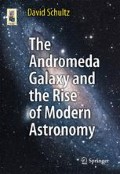Abstract
The Great Debate was inconclusive. It failed to resolve a basic dispute critical to understanding the universe: Were we alone in the Milky Way as the only galaxy in the universe or did others exist? Was, for example, M31, the Andromeda Nebula, something distinct from the Milky Way, perhaps a separate galaxy existing on its own, or was it simply part of ours? To conclude that Andromeda was a unique galaxy also had broader implications, suggesting that perhaps other galaxies, in the millions if not billions or more, existed that were distinct from the Milky Way. Additionally, perhaps many of the other phenomena observed in the sky, too, might be separate from the Milky Way? But how to resolve this debate?
Access this chapter
Tax calculation will be finalised at checkout
Purchases are for personal use only
References
Baade W (1944) The resolution of Messier 32, NGC 205, and the central region of the Andromeda nebula. Astrophys J 100:137
Hubble E (1926) A spiral nebula as a stellar system, Messier 33. Astrophys J 63:236
Hubble E (1929) A spiral nebula as a stellar system, Messier 31. Astrophys J 69:103
Hubble E (1934) The distribution of extra-galactic nebulae. Astrophys J 79:8
Hubble E (1982) The realm of the nebulae. Yale University Press, New Haven
Oepik E (1922) An estimate of the distance of the Andromeda nebula. Astrophys J 55:406–410
Stebbins J, Whitford AE (1934) The diameter of Andromeda nebula. Proc Natl Acad Sci 20:93–98
Williams RC, Hiltner WA (1941) Dimensions and shape of the Andromeda nebula. Pub Obs Univ Mich 8:103–106
Author information
Authors and Affiliations
Rights and permissions
Copyright information
© 2012 Springer Science+Business Media New York
About this chapter
Cite this chapter
Schultz, D. (2012). Edwin Hubble, an Infinite Universe, and the Classification of Galaxies. In: The Andromeda Galaxy and the Rise of Modern Astronomy. Astronomers' Universe. Springer, New York, NY. https://doi.org/10.1007/978-1-4614-3049-0_7
Download citation
DOI: https://doi.org/10.1007/978-1-4614-3049-0_7
Published:
Publisher Name: Springer, New York, NY
Print ISBN: 978-1-4614-3048-3
Online ISBN: 978-1-4614-3049-0
eBook Packages: Physics and AstronomyPhysics and Astronomy (R0)

